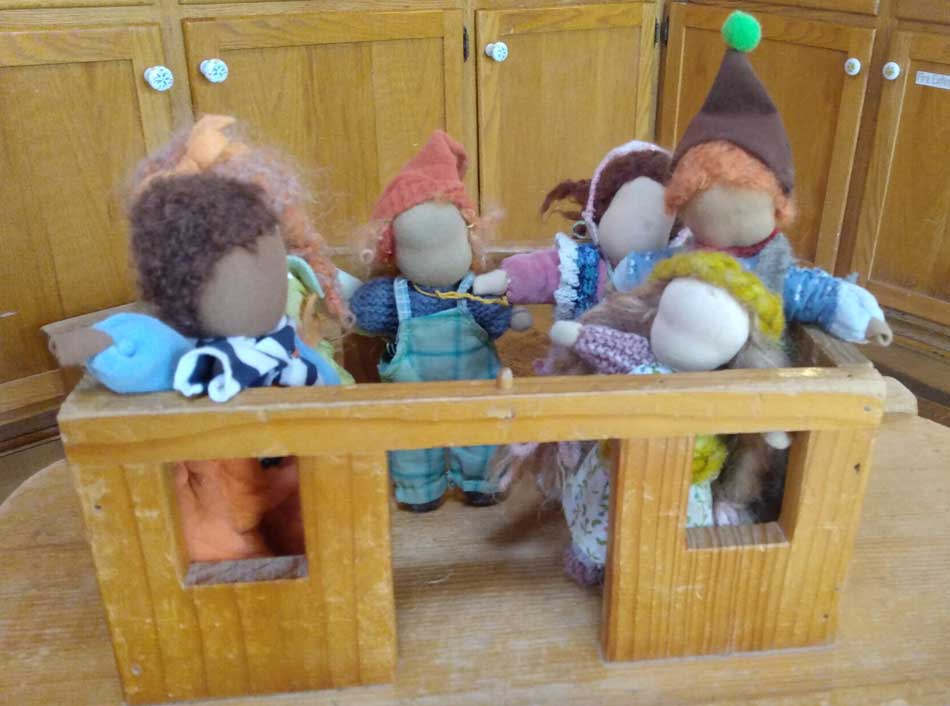“Shhhh…. The babies are sleeping! Now it’s time to wake up and eat
your breakfast…”
The busy work of looking after the dolls has begun. Serious work for the child that requires the caring “parent” to be vigilant, empathetic and engaged. As a teacher I feel that I am a witness to something sacred and precious. I tiptoe around this magical scene, knowing that learning and transformation is unfolding in front of my eyes.
In Waldorf early childhood the doll is regarded one of the most important companions a child can have. From the most simplest form to a more detailed body with clothes the dolls are handmade from natural materials. The doll is the representation of the human child, a mirror of our potential as human beings. When the child plays with the doll they are exploring what it means to be a human being in relationship with others. We are made up of four kingdoms—the mineral, physical substance, the plant world of growth and reproduction, the animal world of instinct, desire and feeling and also the human world of thinking, imagination consciousness and the possibility of self-recognition and selfidentity. A well-loved doll for the child is a part of who they are—an extension of themselves. They explore what it means to love and be loved, to care and to be cared for and what it means to be in relationship. So how is playing with a doll different from playing with a well-loved stuffed animal?
In the early years the child learns through imitation. The experience of separation, which leads to self-identity, is complete at the end of adolescence. The very young child still feels at one with his or her surroundings. When they care for a doll, they care for themselves. When they see a stuffed dog/dinosaur/rabbit they see what is “animal” in their own nature. This is not wrong, of course. We want our children to care for animals respectfully and with empathy. But the gift of being human is that we have freedom to take ourselves in hand and develop ourselves further with the powers of our human self, also known as the “I”. As teachers we support this emerging identity as a humanindividuality by encouraging children to live into what it means to be human through the dolls we provide.
The first doll is the most simple and is a basic representation of the human child—a head and two hands. The child completes the doll with his or her imagination—eyes, a mouth, fingers, etc. This requires the picture-forming processes be awoken and active in the brain. When we give the child a doll with realistic details there is nothing for the child’s imaginative thinking to do—and therefore the brain is less active. This year in Roots and Shoots we have had various kinds of dolls, from the simple knotted dolls pictured below: meet Sky, Sunbeam and Brinjal.

Yet another form of doll we have in Parent and Child classes at my local school is known fondly as a “Heavy Baby”. This is a doll that weighs around 5 lbs that is filled with millet. Millet has a warming quality and is moldable and has weight. The play of the very young child mostly consists of carrying dolls around as they move. Gradually they will begin to feed the doll—but the first play is very physical and involves picking up the doll and moving it to another location. The weight of the doll increases the effort required to do this! It speaks to the child of the physical world, and helps the child experience their own body strength and effort. This reinforces a healthy sense of self without bringing selfconsciousness to the child too early. (Selfconsciousness is a process of thinking about yourself. During adolescence the young person works to incorporate their consciousness of self into their identity. The maturation of the pre-frontal cortex supports this process at this time. When a child becomes selfconscious too young this can call on forces prematurely and can contribute to a gesture of precociousness.)

In our kindergarten we also have the well-loved tradition of Little Ones. During the last year of kindergarten each child receives a “Little One”, a small handmade doll with a delicious name (part of the identity and personality). Over the years we have had Hazelnut, Sunblossom, Tom Twinkle and Periwinkle! This is a special moment for the child—for up until then all the toys and play resources belong to all children in the class. Now they have their very own doll. The younger children watch and wait, wishing for their Little One to mysteriously arrive. And what adventures the Little Ones have! Occasionally they go on a trip to their child’s house and sleep in the child’s bed! They will accompany the child when it is time to leave kindergarten and become a student in Grade One.

When we make dolls we consider how we are representing the human being. Having different skin tones, hair texture and clothing can help children identify themselves and others in the dolls.
Representation is a play between specific identification (eg. AfricanAmerican or Asian etc.) and the universal picture (all human beings have a head, a body and some kind of limbs). We strive to be specific and at the same time to leave the child free to “clothe” the doll with their own imaginative pictures. This is an opportunity to be inclusive and to represent others through diverse skin tones.
Sometimes this leads to conversation and sometimes it doesn’t. We hope to provide a picture that there are many different ways to be and yet there are aspects that unite us all.

